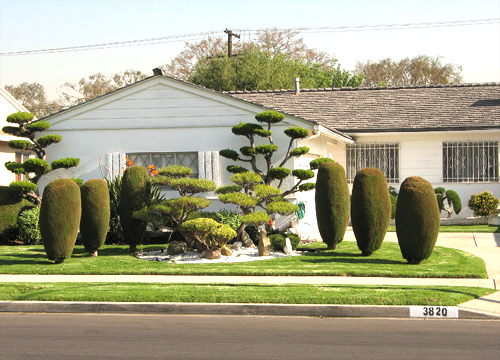|
|
|
[p. 2 of 5]
[Revoyr continues]... went up in flames. People left with their children to try and be in quieter places, safer places. Japanese had already started to leave, but then you also had a mass exodus of middle-class African Americans. There wasn't a replacement generation for the sixty- / seventy- / eighty-year-olds who came out here and ate and bowled, who'd been coming here for fifty years.
When you walk around the neighborhood you see that there are a lot of Japanese folks here still. Even though this is kind of the heart of black LA, there have always been people of all races here, just like in Little Tokyo. Even at the height of Little Tokyo being the center of the Japanese community, there were always Mexicans there, which is something that people don't really know. So I think that when people talk about race in Los Angeles, it's a very simplified reaction to what's out there—not really looking beyond to see what the reality might be.
You know, I would love to walk around when we're done here and kind of see what's out there.
We walk outside and Revoyr shows me the Walgreens around the back, which used to be the bowling alley. We both take some pictures. Then we walk around the block into a residential area.
Revoyr: This is what Gardena looks like. There are all these modest but nice single-family houses with very meticulous Japanese-style landscaping—you see those trees that are kind of styled as bonsai trees? This is not what you would see in parts of South Los Angeles necessarily, that are not so Japanese influenced. Some of these houses are occupied by older Japanese couples or singles, but also many of them are African American. The people who have grown up in this area have been so influenced by Japanese aesthetics that even black people will have these bonsai style trees outside of their houses. I would venture that most of these families are black. But you see the [Japanese] influence in the aesthetic.
We pass by a middle-aged African-American man standing in his driveway.
Revoyr: Hi there.
Man: How are you?
Revoyr: Pretty good, just admiring the neighborhood.
Man: [in a bemused tone] Lots of people do.
Revoyr: Yeah. It's a beautiful place. Enjoy the day.
LRS: I had no idea this was here, this neighborhood, and it's just on the back side of the big boulevard.
When did you find this neighborhood?
Revoyr: It was part of the coming to the Holiday Bowl and once I realized it was here, you know, I just drove around it. What really struck me was how much it looked like Gardena. It's really similar: the size and style of the houses—they were probably built in the same era—the width of the streets, the sunniness is very resonant of Gardena.

LRS: What's your connection to Gardena?
Revoyr: When I first moved to the US from Japan the first place we lived was Wisconsin. It was not the most racially accepting place, so when we moved to California it was really a mind-blowing, wonderful experience, and it was the first time that I had the ability to be around Japanese people in America. My father, who is my white parent, became the manager of a Japanese restaurant in Gardena. For two or three years while he was doing that I was in elementary school or junior high. I hung out at the restaurant all the time, but he would come pick me up after school because I was too young to be by myself. I'd hang out at the restaurant and wander around the streets of Gardena after school.
You know, it's funny, the last time I did this walk it was also really unseasonably hot.
LRS: Yeah, we should say it's November 17th and it's probably—
Revyor: Eighty—eighty-something degrees? Yes, it is very unseasonably warm.
Revoyr points out a Japanese name on the watch and jewelry repair sign—now we've rounded and corner and are walking on Crenshaw again past a row of shops.
Revoyr: There used to be several different Japanese-owned businesses here, and then there's this soul food restaurant that clearly [used to be] a Japanese restaurant.
LRS: People always talk about LA being a car city, but you wouldn't see all of this if you're just driving by. You really have to get out and walk around.
Revyor: [peeking into a store with an incense display in the front] I thought that was Asian stuff.
LRS: Asiany.
Revoyr: [Laughs] Yeah. Asiany.
* * *
Part II
Little Tokyo
Hanaichimonme ramen restaurant in the Little Tokyo mall at 3rd and Alameda
LRS: I read Susan Straight's LA Times article about regional writers in which she mentions you. She also talks about Joyce Carol Oates, saying that homesickness is one of the impulses for great writing. You've also said that Southland was in a way a love letter to LA, but that you can't write about LA when you're here. I was wondering how that works out in your life, how you work that out being back here.
Revoyr: That's a good question. I totally agree that homesickness and loss are a big part of what enables you to recreate something so vividly. Also, if you continue the love letter analogy, it's very hard to write a love letter to someone when they're sitting in the room with you—it tends to be when you're away from them. So I think that that's definitely true. There's something John Updike wrote in The New Yorker recently about this very issue, saying that it's important to be away from a place so that you can remove yourself from the clutter of ongoing experience, which I thought was really interesting. That was definitely true for the first two, three years I was away from LA, in the mid-'90s. But I was out of town
[continues...]
|
|
{buy the by}
|

